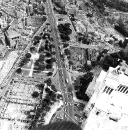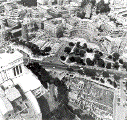The Forum Area
Forum of Nerva
 The excavation of
the Forum of Nerva was the first archeological intervention in the central city that began
after the war and continued on until today. The excavation finished a few months ago after
obtaining evident results of scientific importance and of enormous interest to the public
who were able to visit the site on guided tours organized by the Superintendent during the
summer months. The excavation of
the Forum of Nerva was the first archeological intervention in the central city that began
after the war and continued on until today. The excavation finished a few months ago after
obtaining evident results of scientific importance and of enormous interest to the public
who were able to visit the site on guided tours organized by the Superintendent during the
summer months.
Offered to Internet site
navigators is a large excursion of recent findings in the Forum of Nerva- the first
intervention that will constitute part of the Imperial Forum Archeological Park.
Even though archeological
excavation has the risk being destructive or invasive, it is nevertheless possible to
conserve stratigraphs as demonstrated in the excavation of the Forum of Nerva. These
stratigraphs represent different epochs of time that began with the development of Rome
and the Imperial Forums. With pride we can now affirm to very important successions in
Rome's history based on the digging in the archeological area. Uninterrupted layers of
history begin with the II century B.C. to 1930 along with perfectly visible and
comprehensive interiors of the Forum of Nerva. Today, the cellars of antique buildings,
smoothed to the surface during the opening of Via dell'Impero, have walls from the
preceding epochs integrated into the modern ones, conserving some of the most significant
findings of the Forum discoveries.
This first phase is just a part
of a bigger and more fascinating one that lies ahead in the near future with the upcoming
year of 2000. There is also undoubtedly a connection between historical sources and
gathered news from the Imperial Forums and the findings in the Forum of Nerva.
 The first example of notable
interpretation of archeological data connected to historical references was found in the
southern area of the Forum, bordering the Roman Forum. The first example of notable
interpretation of archeological data connected to historical references was found in the
southern area of the Forum, bordering the Roman Forum.
Wanted by Domitian, dedicated to Nerva, but known as the Transitory Forum in late
antiquity- the Forum of Nerva was erected on the site of Argiletum. This was an antique
quarter from the republican epoch divided into two sectors by one street. Until the first
republican epoch the site connected the Roman Forum with Subura- the most populated and
popular quarter in Rome.
An archeological excavation that
began in 1995 in the areas between the Curia, the Basilica Aemilia, and the southern side
of the Forum of Nerva, had already brought forth a series of important data relative to
the organization of the quarter.
In fact, on that occasion, they revived two large segments of peperino slab pavement dated
to the 3rd century B.C. which was evidently renovated in the augustan epoch- referred to
as the Macellum. This was a grand market of the Roman republic where commercial buildings
were probably concentrated to the right of the street. Following this was the occupation
of the Templum Pacis, the Forum wanted by the emperor Vespasian between 71-75 A.D.
Along the left sector, rather, historical sources have always defined the existence of a
quarter with notable residential characteristics. In fact, it was constructed by rich
domus, apparently powerful people from senatorial aristocracy that also rented out
apartments.
The wealth of information derived
from historical sources have managed to identify some of the rented homes overlooking
Argiletum, owned partly by Cicero. Cicero's correspondence with his friend Attico
emphasized the necessity to send money to his son- who was able to study in Athens thanks
to money made from renting homes in Argelitum.
In reality it is now known that
Cicero, together with his brother Quinto, got rich by acquiring houses in the Argelitum
quarter. After having sold the Tusculum property, not yet received by Caesar, the
objective was to expropriate as much area as possible for the construction of the Imperial
Forums, that took the name of Caesar himself. It would have been nice to have found
remains from these houses of Cicero in the excavation of levels from that period. In fact,
findings were recovered in only three sectors, and it would be ideal to cover the whole
area which is usually difficult with limited available funding.
In this specific case, the excavation work was financed by laws 396/92 for the capital
Rome, with a total cost of 3 billion lire.
Further examination of the late-republican layers is foreseen for both the Forum and the
complete excavation Project of the Imperial Forums financed by the Municipal
Superintendent for the Jubilee. This will help complete the research that has been
difficult due to the successive monumental intervention over the years until the
realization of the Domitian foundation.
In the three sectors investigated so far, they have identified
subterranean structures accessed by a series of stairs. One of the staircases in the site
leads through corridors with pavement in opus spicatum leading further to a series of small rooms, some of which have mosaic
pavement. The typology of the foundation together with the presence of skylights, iron
railings, and niches in the walls for wooden beds lead to the identification of these
rooms as an Ergastula (prison): small lodges constituted in a sort of
barred cell where employed slaves were kept for the rich domus.
One of the ergastulas was completely excavated in a way to provide access to one of the
small rooms. This can give us an example of the layout of the other similar environments.
The small room examined seems to
hold findings from two different chronological periods. The oldest has been dated to the
end of the 2nd century B.C. based on the mosaic pavement style, while the
successive period is from the 1st century B.C.
The mosaic typology of the first piece suggests that the room served a different function
before its use as an ergastula. This piece is a square shaped wall panel designed with a
phallic male figure swimming near a large dolphin-whale hybrid. In good condition and
obvious antique repair work, the panel contains colored marble inserts. Meanwhile, the
second mosaic piece is a rectangular shaped floor section in black and white. This piece
contains a motif suggesting that it was probably part of the city wall.
Finally, mosaic wall fragments
with geometric and plant-like designs have been found together with a series of water
drains. Based on these findings it can be assumed that the building was originally used as
a thermal bath.
Moreover, they have not excluded the theory that a series of these spaces were used as
part of the Macellum, with the subterranean areas used as slave's quarters, who
were sold during the day in the market.
It is known that the progressive transformation of the southern
Argiletum section lead to the replacement of houses and commercial buildings. These were
later transformed into a large public complex that ended up laying the foundation for the
Forums of Caesar and Augustus.
Nevertheless, even before the support of archeological documentation, historical sources
agree that after a fire in 64 A.D., there was a general reorganization in the Argiletum
area. According to the antique sources of Tacitus, Suetonio, and Cassio Dione, this plan
prepared the site for a new extensive urban project under the command of Nero- new
architect of the city.
One of the first architectural foundations, isolated in the new area, was identified as a
structure for a section of porticos. For now it is impossible to identify the typological
development of the complex based on the limited investigation. However, with a strong
similarity to the Horreum remains from the northern slope of Palatino- the structure could
be identified as a large commercial building from the Neronian era.
In one case, sources were not supported by archeological data from the
Forum excavation. Sources referred to the existence of a Temple of Janus by the great poet
Marziale. Too attached to the regime, he praised and described this temple before it was
ever realized.
Archeological evidence found what seems to be the first phase of the project for the
Temple of Minerva- a large foundation of an entire perimeter has been recovered. the
Domitian architect Rabiro erroneously planned its position at the border of the Basilica
Aemelia.
In such a position the temple would have interfered with a large part of the piazza and
blocked the longitudinal axis from the Roman Forum to Subura.
Furthermore, this layout would have allowed the Domitian Forum to be the only accessible
among the existing Forums.
In one case, historical evidence did not match with archeological data excavated from the
Forum. Sources referred to the existence of the Temple of Janus, praised and described by
the great poet Marziale before it was ever realized. The archeological evidence, rather,
found what seems to be the first phase of the project for the Temple of Minerva- an
enormous piece of foundation of an entire perimeter. The Domitian architect Rabirio
mistakenly planned its position at the border of the Basilica Aemelia. If located here,
the temple would have interfered with a large part of the public piazza and, above all,
would have blocked the longitudinal axis from the Roman Forum to Subura.
Furthermore, this layout would have allowed the Domitian Forum to be the only one
accessible among those already existing.
In fact, once the foundation was eliminated by laying down the pavement of the piazza, the
Temple was designated to the northern section. Here, Domitian was able to realize a
perfect centralization of his Forum in respect to those of Augustus, Caesar, and Vespasian.
It would be nice to imagine that the Temple of Janus was located in the center of the
Forum - being the ideological center of the new Domitian political and urbanistic order.
Some important finds from the
Charlemagne era were recovered during excavation work. This has been the only case of its
kind in Rome.
Not only were these structures consistently conserved between the 9th and 11th centuries,
but they also provided the possibility to study post-classical architecture first hand. In
the past, these findings have always been scarred by non-scientific archeological
intervention (such as the digging for the building of roads).
Following the forum area's alternative use as a medieval center or as a swampy marshland,
sources document a land purification and systemization taking place in the first decade of
the 1600's. This was due to the installation of an important sewage system. One of the
water ducts revived during excavation was evident to be constructed in the Forum of Nerva
area. The sewage network, using recycled materials from the Forum buildings, ran from the
southern section toward the north, following a parallel direction to Argiletum (but
higher).
Considering the largeness of the
sewer and the capacity of water flow, it is easy to imagine the magnitude of the sewer
complex. Nevertheless, the importance of this find is of a different nature. In fact, the
strategic position of the Chiavicone (large sewer) allowed a comprehension of the entire
urban fabric of the Imperial piazzas which were disarranged by the construction of Via del
Impero. The position of the Chiavicone also marked a moment of great importance related to
the definite systemization of the area from the Roman Forums to the Imperial Forums.
Thanks to the removal of debris
in the sewer system, it is today the only passage connecting to the antique level. These
passages not only lead to the 2 sections (divided by modern roads) in the Forum of Nerva,
but they also allow visitors to reach the completely recovered Forum of Nerva. This is
accessed by entering the Roman Forum from the arch of Titus and following Via Sacra.
Finally, thanks to this perfectly adjusted Chiavicone, it is also possible to enter the
other forum piazzas following one continuous path.
All the forum areas and Coliseum until the piazza Venezia, between the Roman Forum and
Imperial Forums, will be recovered by the end of the Imperial Forum Project. As a result,
a one of a kind Archeological Park will be realized with the inclusion of the historical
element -Via dei Fori Imperiali. This via will contribute as an elevated passageway to
emphasize the fascination of the entire antique site.
The temple at the bottom of the Forum, dedicated to Minerva (Domitian's
protective divinity) had survived in good condition until 1606 when Pope the Vth had it
destroyed so the materials could be used to build the Fontana di Acqua Paola sul Gianicolo.
The recent excavations from
1995-96 have demonstrated that the Forum was located in an area formerly occupied by a
residential area destroyed in a terrible fire in 64 B.C. Also, the systemization of the
Forum was proceeded by still another three phases of edification that were probably never
brought to completion. The last of these phases planned the construction of a great
temple, which was to be located opposite the completed Temple of Minerva.
> Series of unpublished photos and images of the
Forum of Nerva
> Forum of Augustus
> Forum of Caesar
> Temple of Peace
> Forum of Trajan
> Trajan's Market
> Presentation of
the operation
> Imperial Forum area
> Methodology of the
archeological excavation
> News from the Forum
workshop
> The staff engaged in
recovery |



